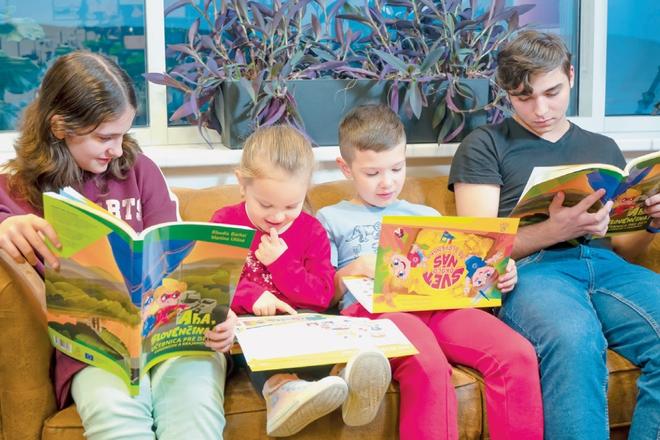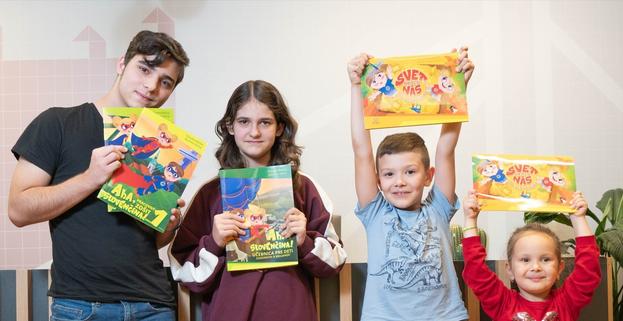For years, children of foreigners and those who were born abroad to Slovak parents struggled when they entered schools in Slovakia. The schools were not ready for their arrival, and there was one big obstacle that was hard to remove – the language barrier, as Slovak has not been taught as a foreign language.
This can now change. In May 2023, the Education Ministry officially recognised the first textbooks that teach Slovak as a foreign language. Issued by the private language school iCan, they were created for children of foreigners and Slovak expatriates who would like to return to their home country.
“Language is the first step on the way towards the well-being of children in Slovak society,” said Alona Kurotova, CEO of the relocation company Alkur and director of the iCan school network. “These children come from a different environment and need support to start feeling at home here.”
Children need support
When Russia annexed Crimea in 2014 and the number of people coming to Slovakia who do not know the language increased, Kurotova, who comes from the peninsula, established a foundation to finance activities related to their integration into society. Two years later, a language school was opened.
They soon started focusing on children of both foreigners and Slovaks living abroad, aged 5-18. At the time, there were no official textbooks that would make it easier for them to get a grasp of Slovak, and be able to understand not only the curriculum, but socialise and make friends.
“As a mother, I realised that children need to feel good at school,” Kurotova said.
What she witnessed, though, was that these children were often simply placed in a lower grade and were left to attend classes without understanding what was going on.
For each level of language skill
After attempts to persuade the Education Ministry and other relevant players in the field to prepare the educational materials, Kurotova decided to make the textbooks in cooperation with the National Institute of Education and Youth (NIVAM) and Slovak compatriot organisations in the world.
The project, co-financed from EU funds through the Erasmus+ programme, started in 2019 and ended in 2022.
Even though the standards for the textbooks were not officially approved at the time, they put together a team of authors, including the author of Slovak spelling books Zuzana Hiršnerová and Markéta Kaksa Filagová, and university teachers focused on teaching Slovak as a foreign language, Klaudia Báčkai and Martina Uličná.
They wrote seven books, each of them focusing on a different age group of children and different language levels.
There are books for pre-schoolers, pupils attending grades 1-4, and pupils attending grades 5-9. Another textbook was designed for children of Slovaks living abroad to help them pass the competency assessment. In addition, they wrote a dictionary with basic vocabulary in six languages – Russian, Ukrainian, English, Vietnamese, Serbian, and Hungarian.
Finally, there is a manual for the inclusion of children into Slovakia’s education system, authored by the National Institute for Education and Youth (NIVAM)
Tested in real conditions
The textbooks are truly unique, teaching children Slovak through various games and fun activities. Colouring pictures is one activity for the youngest age group, while older children have various cards and pictures to play with, as well as recordings.
“We decided to implement child-friendly principles, so that pupils using these textbooks will truly want to learn the language,” Kurotova explained.
Individual chapters were tested abroad by the kids of Slovaks living in Ireland, the United Kingdom and France, where large communities of emigrants who left the country in the 1990s live. Many of these children were born abroad and have minimal contact with their parents’ mother tongue.
“We wanted to help them keep the language,” Kurotova said.
Thanks to the feedback they received, they created high quality textbooks that were appreciated by experts from both Slovakia and abroad.
“We even won the European Language Label of EU in 2022,” Kurotova added. It is an award encouraging the development of new techniques and initiatives in the field of language learning and teaching, as well as the enhancement of intercultural awareness across Europe.
The textbooks are already helping at Slovak schools. After the war in Ukraine started in February 2022 and children of Ukrainian refugees started attending Slovak schools, UNICEF paid to print 15,000 copies of books that were delivered to these pupils for free.
After they were officially recognised as textbooks by the Education Ministry in May, they are now available to be bought and used to teach Slovak as a foreign language. To help teachers understand how to use them, Kurotova and her team launched another project, focused on manuals.
“Our next step will be to encourage schools in starting teaching Slovak as a foreign language, so that children will not be left to learn the language on their own. We have prepared manuals on how to use textbooks and I hope it will help teachers in their work,” Kurotova said.
This article has been brought to you by Alkur s.r.o.
 Alkur
Alkur


 Courtesy of Alkur s.r.o.
Courtesy of Alkur s.r.o.
 Photo: Courtesy of Alkur s.r.o.
Photo: Courtesy of Alkur s.r.o.